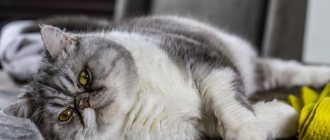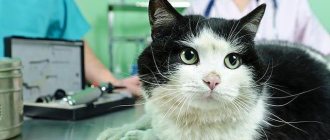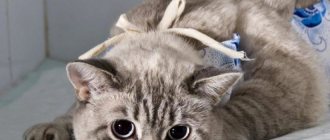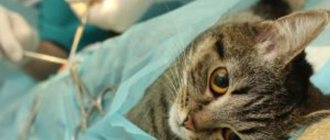Many veterinarians are so experienced in sterilizing cats that they can easily perform this operation even at home. This indirectly indicates the comparative simplicity of this procedure. However, not everything is so simple: if a cat trembles after sterilization, the owner should pay close attention to the state of its health.
How do cats behave day by day after sterilization?
The general condition and behavior of the cat after sterilization changes daily.
Day 1
On the first day after surgery, the cat has no appetite, lethargy, drowsiness, coordination of movements is impaired, hallucinations and disorientation may occur - the pet tries to run or crawl in an unknown direction, stops abruptly, runs into walls, falls and falls asleep, jumps up, etc. This behavior is normal and there is no reason to worry.
The cat may not blink, in which case it is necessary to close her eyes yourself until she starts blinking again, otherwise there is a risk of drying out the cornea.
In addition, involuntary urination and vomiting are possible.
On the first day after sterilization, you need to be close to your pet and monitor its condition. You cannot feed the animal, but only give it water from a syringe or pipette.
Day 2
During the second day, the cat begins to come to its senses, its behavior becomes more adequate. The pet has a desire to hide in dark, hard-to-reach places, so it is necessary to monitor it and constantly keep it in sight.
If a cat is in pain, it may try to bite someone who tries to touch it.
At this time, the animal shows a desire to lick the area near the incision and reacts too excitedly to all extraneous sounds.
On the second day, you can put water near the animal and start feeding it in small portions.
Day 3
On the third day, the cat fully comes to her senses: she is active, reacts with interest to what is happening around her, goes to the litter box and begins to ask for food.
You need to measure your pet’s body temperature twice and, if the readings are elevated or decreased, contact your veterinarian.
Due to the fact that anesthesia can slow down intestinal motility, it is necessary to monitor the regularity of bowel movements and, in the absence of bowel movements, you can give the cat mild laxatives.
Day 4
On the third day after sterilization, the cat should eat and drink independently, and should actively urinate and defecate.
Day 5
On the fifth day, the swelling and redness near the suture subsides, and scarring begins.
The cat is becoming more and more active and can now walk around the apartment.
And if before the operation the pet had access to the street, then into the yard, you can jump on low surfaces.
Day 6 and 7
By this time, the pet’s activity and appetite are completely restored, pain completely disappears, urination and bowel movements occur as usual.
The well-being of a cat after sterilization depends on several factors:
- age at the time of surgery;
- whether the procedure was planned or emergency;
- type of anesthesia used.
After recovering from anesthesia, the animal may experience pain, which usually goes away on the second day. The main signs of postoperative pain are:
- manifestation of aggression;
- dilated pupils;
- prolonged immobile stay in one position;
- gaze directed at one point;
- refusal to eat.
To alleviate your pet's condition, you should give her a painkiller injection or give her an anesthetic drug orally.
Postoperative behavior depends on the individual characteristics of the cat, its psyche and stress tolerance.
After sterilization, some animals may consider themselves completely healthy, not feel any discomfort, continue to lead their usual lifestyle, or become hyperactive.
We suggest you read: How to treat sneezing in cats
This behavior negatively affects the recovery process. Due to increased activity, a cat may bite, scratch, show aggression towards people or animals around it, and attack them.
It is better to prepare for this behavior of your pet in advance by equipping it in a cool, calm, isolated place. It is necessary to limit the animal’s movements, ensure complete rest, and you can add sedatives to the water.
Sterilization leads to the cessation of the production of sex hormones that reduce appetite, so in a sterilized cat it increases, metabolic processes slow down, as a result of which the pet’s body weight may increase.
It is necessary to control the amount of food your cat eats and feed it with specialized food often, but in small portions.
Display of aggression
Surgery and recovery from anesthesia are stressful for the animal. The cat is in pain and reacts overly excitedly to surrounding sounds, any noise and people around. All this affects behavior that may become uncharacteristic for her: the pet may hiss, growl, try to bite and show aggression.
Loud screams and aggressive behavior from a cat indicate that it is experiencing severe pain or nausea. If your pet screams for a long period of time, you need to contact a veterinarian who will examine her, determine her condition and, if necessary, prescribe painkillers.
Also, during the postoperative period, the cat may scream if an incomplete operation was performed - in this way the pet demonstrates character and asks the cat. In such a situation, the best solution is to perform a complete operation to completely eliminate the cat's sex drive.
In addition, a cat may scream in order to attract the attention of the owner.
The cat is shaking on day 2
Signs of hypothermia, intoxication and pain accompanied by trembling may persist for 2 days after sterilization.
You can alleviate this condition:
- the use of painkillers approved by a doctor;
- rubbing paws;
- placing a heating pad under the cat's back;
- drinking plenty of water.
Sometimes, to quickly relieve intoxication, veterinary specialists perform intravenous injections with saline and glucose.
Lack of vitamins and minerals
If there is a lack of B vitamins, calcium and magnesium in the body, the cat develops nervous phenomena, manifested by muscle tremors (shaking) and convulsions. Despite the fact that hypovitaminosis develops gradually, the owner may not notice its clinical signs for a long time. But severe stress and anesthesia provoke a sharp deterioration in the female’s condition and the appearance of pathological symptoms immediately after sterilization.
This problem can be eliminated by introducing vitamin and mineral supplements into the diet, selected taking into account the age, body weight and breed of the cat.
Myths about castration and cats
To begin with, it is useful to dispel some prejudices that point to false reasons for an animal’s aggressiveness.
- Revenge for missing testicles. The misconception is a consequence of the humanization of the animal. In fact, the cat does not know the meaning of the operation, does not understand that something important was cut off for him. Moreover, the pet does not count its internal organs and does not know about their purpose.
- They cut off something wrong. This is impossible, since there are simply no extra “wrong” organs in the scrotum. Most likely, the problem may lie in the fact that they did not cut off what was needed, in particular, they left one of the testicles in the scrotum. For example, they simply forgot.
- Consequences of anesthesia. This is unlikely, since there is no connection between it and aggression. Anesthesia can have complications, such as brain damage, respiratory arrest and other dangerous pathologies. But bitterness is not on this list.
Trembling on day 3
The presence of tremor on the 3rd day after sterilization indicates the development of an inflammatory process, especially if it is accompanied by:
- an increase in local or general temperature;
- refusal of the animal to feed;
- excessive lethargy and apathy;
- tension or pain in the abdominal wall;
- discharge of serous or purulent exudate from the wound;
- redness of the incision area.
In this case, it is necessary to call a veterinarian at home or take the female to the clinic, since in addition to conservative methods of therapy, surgical intervention may be necessary.
Important! Trembling, caused by natural physiological factors, gradually weakens and passes, but with the development of pathology, the tremor intensifies.
Weakness and exhaustion
Trembling of the limbs when a cat refuses food for a long time after sterilization can be caused by weakness, especially if the situation is aggravated by vomiting or diarrhea. In this case, injections of nutrient solutions, the use of antiemetic drugs, as well as agents that improve intestinal function help.
Surgery should not be performed if the female's body mass index is below normal. An exhausted animal tolerates anesthesia more difficultly and suffers more often from complications. They are also characterized by longer wound healing and increased recovery time.
What could be the cause of aggression?
There are few possible reasons for an inadequate reaction; the mechanism for the development of aggressiveness differs greatly depending on the cause.
Recovery from anesthesia
Based on how your pet reacts to anesthesia, recovery can last anywhere from two hours to a day. At this moment, the cat feels disorientated, vomiting, muscle spasms and weakening are possible. All higher factors can be the cause of an animal’s aggressive behavior. This is a normal and understandable reaction to a frightening, unusual condition.
To alleviate the cat’s situation, you need to follow a number of simple recommendations:
- It is advisable to pick up the cat immediately after the operation is completed. An unusual place, a strange condition and the presence of other animals are not the best conditions for eliminating stress. If you need to travel in public transport, it is recommended to put the cat in a covered carrier, where he can hide from the outside world.
- At home, place the cat in the shade in a warm place. It is necessary that the lounger be at floor level, as the animal will try to stand up, but its balance will be disrupted. Place a bowl of water nearby so that your pet does not have to walk far.
- If the cat does not show aggression, then sit with him, pet him, talk. This will calm your pet and give him a feeling of security. Otherwise, when an animal is embittered, on the contrary, it should not be disturbed; it should be left alone, let it calm down and make sure that nothing threatens it anymore.
We invite you to read: Estrus in cats, features of the reproductive cycle
Castration is a very quick and simple procedure, after which the pet should not feel severe pain to show aggression. If the pain is strong enough, causing the cat to become embittered, it is necessary to exclude possible complications after castration.
Signs of complications are:
- the pet’s aggression continues for more than two days after the operation;
- the cat has a high body temperature;
- increased heart rate or breathing;
- the animal does not allow itself to be touched;
- the pet refuses to jump, does not run, walks with caution as if something hurts;
- there is swelling in the perineum, discharge of pathological colors;
- Vomiting, diarrhea and other signs of infection are observed.
After surgery, the cat’s behavior may not change for 2-2.5 months. This is due to the fact that adjustment to a new level of testosterone does not occur immediately, but gradually. Also at this time the level of aggression may increase slightly. This is also due to changes in hormonal levels and completely disappears by the end of the third month.
Such manifestations are very rare, but if this does happen, then several rules should be followed:
- for a three-month period you need to be very careful with the cat, monitor its condition and, if there are signs of aggressiveness, leave it alone;
- You can’t irritate and punish him too much, you can play, but in moderation and not for too long;
- You cannot punish a cat for aggression.
Incomplete castration
This is when a surgeon fails to remove one of the testes for various reasons, usually as a result of negligence or inattention. Removing one testis does not reduce the level of aggression, since the testes have some compensatory mechanisms. When only one testis is removed, the second one increases in size and produces 2 times more hormones.
Signs of this particular reason are that, along with aggression, the cat exhibits sexual desire, continues to mark the territory and demand the cat. You need to go to another clinic to have your testosterone levels examined. If the testis is found, you can request a second free castration.
It is possible that the cat is simply in a bad mood, which has nothing to do with castration. The causes of a depressive aggressive state can be:
- The pet's desire to rise up the hierarchy and show everyone who is in charge.
- Intraspecific aggression manifests itself on other cats.
- Territorial aggression means that the animal continues to guard its marks. It is necessary to thoroughly clean the apartment and eliminate all odors.
- It happens that people mistake a particularly gambling game for aggression, since cats do not calculate their strength.
We invite you to familiarize yourself with: Persian cat: appearance and character, varieties and description of the breed
Anesthesia dissolves the animal's consciousness, but does not provide pain relief. Therefore, veterinarians combine anesthesia with local anesthesia. However, if the assistant is negligent and there is insufficient anesthesia or anesthesia, complications may arise:
- The pet does not feel pain (there is anesthesia), but hears doctors (there is no anesthesia). In this case, the natural result will be panic in the pet, which may later turn into anger, but this does not always happen.
- The pet feels pain (no anesthesia). The natural reaction is shock, and subsequently aggression. The purpose of this behavior is to eliminate the likelihood of recurrence of pain. There may be a decrease in trust in the owner (after all, he was the one who brought it to the clinic).
In any case, the likelihood of such complications is minimal, according to statistics one in a million. So this type of cause should be suspected only in the latter case.
Possible problems
Castration is one of the most common and popular operations in veterinary practice. It is worked out in the smallest detail, and in itself is not too complicated. Intervention in the body is minimal, so postoperative complications are extremely rare. However, the operation and especially the effect of anesthetics can still affect the functioning of the animal's body.
One of the most common problems is constipation. After castration, a cat may not have a bowel movement for several days. This is a dangerous condition, since feces contain toxic and harmful substances, which, stagnating in the intestines, begin to poison the body. Therefore, you need to fight constipation.
You can add a couple of drops of vegetable oil to your cat's food, this will make it easier for the cat to move through the intestines and pass feces.
Under no circumstances should you give your pet human medications to relieve constipation.
Diarrhea after anesthesia is quite rare. Most often, this is how the body reacts to a stressful situation. But sometimes it is a sign of the development of a bacterial infectious disease. If there are other symptoms of infection, the animal should be seen by a doctor immediately.
If your pet had any chronic pathologies before surgery, they may worsen during this period. The owner should closely monitor the condition of his cat and, if necessary, immediately contact a veterinarian.
The most dangerous complications, as a rule, begin to appear within two or three days after surgery. If this period has passed and the cat has begun to eat, go to the toilet and generally behave as usual, then there is no reason to worry.
How long does it take for an animal to move away?
The cat sterilization operation is performed in a veterinary clinic and lasts approximately 40 minutes. The length of time the animal recovers from anesthesia depends on which of the three types was used:
- Muscle relaxants analgesics. This mixture is used most often as it is the most effective. A significant disadvantage of such anesthesia is the difficult and rather long recovery from it, which lasts from 5-6 to 24 hours.
- Muscle relaxants along with epidural anesthesia. When using this type of anesthesia, the experience and qualifications of the doctor play an important role, since if the injection into the epidural space is performed incorrectly, there is a risk that the sensitivity of the hind limbs and the ability to move them will return within 48 hours. The advantage of this mixture is its low toxicity, due to which anesthesia is easily tolerated and recovery from it takes a maximum of 8 hours.
- Gas or inhalation anesthesia. This method is highly effective and minimally toxic, but it is used infrequently due to the lack of necessary equipment and substances. After such anesthesia, the animal comes to its senses almost immediately after the anesthesia machine is turned off.
First aid for seizures
Seizures in a cat are a serious sign of pathology. Any pet owner should be prepared for the appearance of such a symptom, and should also know what to do to alleviate the pet’s condition.
First of all, you need to take the cat to the flattest surface in the house, covering it with an unnecessary rag or a disposable diaper. It is worth remembering that it is not recommended to forcibly hold the animal, and also try to unclench the clenched jaws.
Do not give medications to relieve pain and cramps through the oral cavity. This is due to the fact that during an attack, certain muscle groups in a cat contract and the animal may simply choke on the medications.
You can try giving your pet a light massage in the place where uncontrolled muscle contraction was observed. The occurrence of even one seizure attack is a reason to consult a veterinarian. You shouldn’t let the situation take its course and wait for the next attack.
How to help your pet?
There are a number of recommendations from veterinarians for the process of cat rehabilitation at home:
- you need to put the pet on the floor, since due to impaired coordination of movements after anesthesia, it may fall from a hill;
- the cat should not lie near heating appliances - this can cause internal bleeding;
- It is worth laying down an absorbent diaper, as the cat may spontaneously urinate, defecate or vomit;
- you need to put the pet on its right side to reduce the load on the heart;
- if a cat has a weakened immune system, it needs a course of vitamins and restoratives;
- in the first hours after surgery, it is necessary to measure the cat’s temperature once an hour and carefully turn it over every half hour to avoid numbness in its paws;
- if ulcers, crusts, rashes or redness form in the suture area, consult a veterinarian;
- in case of sudden vomiting, it is necessary to turn the cat’s head to the side and make sure that it does not choke;
- to prevent licking and scratching of the stitches, as well as to protect the wound from dust and dirt, you need to put a postoperative blanket on your pet;
- stitches must be treated in accordance with the recommendations of the veterinarian.
If all recommendations are followed, the cat will recover from anesthesia easier and recover faster.
Causes of cat trembling
First, let's look at what causes trembling in cats.
Cold
Cats are warm-blooded animals, and just like their owners, they get cold. A comfortable temperature for pets in the house is +18 - +20 degrees. But if the room is suddenly colder or there is a draft, the animal may poke at you.
Trembling increases if the cat's fur is wet (after bathing). Therefore, it is necessary to wipe your pet’s fur dry after water procedures before letting it into the room (and even more so outside).
Stress
Yes, if the cat is scared, nervous, angry, or has slight tremors (tremors). Usually the fur also stands on end, the tail is like a pipe. In general, recognizing a cat in nervous tension is not so difficult. As soon as the animal calms down, the trembling disappears.
Lack of vitamin B, magnesium or calcium
It happens that due to a lack of vitamins, calcium or magnesium, the animal begins to tremble slightly. There may be seizures. It is enough to add vitamin and mineral supplements to the diet (a course of 10 days), and the improvements will be noticeable.
Fatigue after exercise
If the cat has been running for a long time, the muscles may begin to tremble slightly. Think about yourself after running, how your legs can shake. But once you rest a little, it all goes away. Observe your pet; if the trembling persists for a long time, then the reason is probably not the active pastime of the mustache.
Suture removal and general recovery
Typically, during sterilization, intradermal sutures are placed that do not need to be removed. External sutures are removed on days 7-10, but no later than the 12th, so as not to allow the suture material to grow into the skin and surrounding tissues. Throughout the healing period of the postoperative wound, the suture should be clean, dry, and without signs of inflammation.
How long it takes for a cat to recover from neutering will depend on the environment she is in after surgery, as well as her overall health. Young and healthy cats recover faster than older cats burdened with additional diseases. Usually, by the 5-7th day, only the presence of a postoperative collar or blanket reminds of the operation, and otherwise the animal should already lead its normal lifestyle. Full recovery of the cat after sterilization is observed after 3-4 weeks.
Natural bowel movements, appetite and thirst
It is necessary to ensure that the cat goes to the toilet on the first day after surgery. Frequent trips to the toilet should also alert you, as should the complete absence of bladder and bowel movements. In case of reflex postoperative constipation (no bowel movement for up to 3 days), you will need to give a laxative, after consulting with your veterinarian.
Normal active appetite and thirst should return on the second or third day. By this time, the cat is already showing a normal interest in food and drink, so it is already asking for food and drinking on its own according to its needs. Important: it is not recommended for a cat to eat a lot after sterilization. What to do if he asks to feed often? It is enough to reduce food portions. Neutered cats are prone to obesity due to increased appetite due to hormonal changes, so their diet and feeding regimen will have to be monitored more carefully than before surgery.










